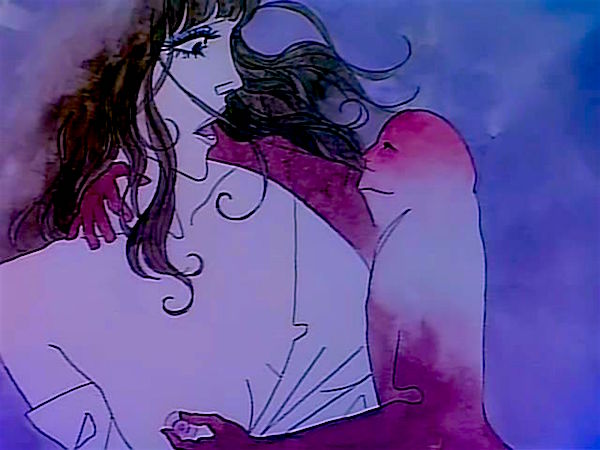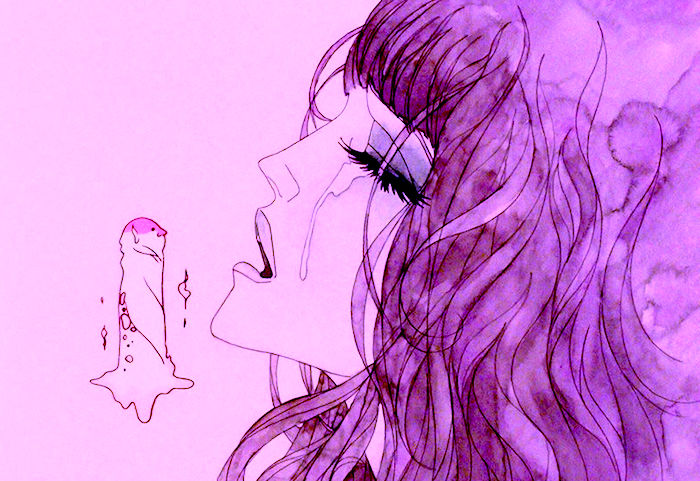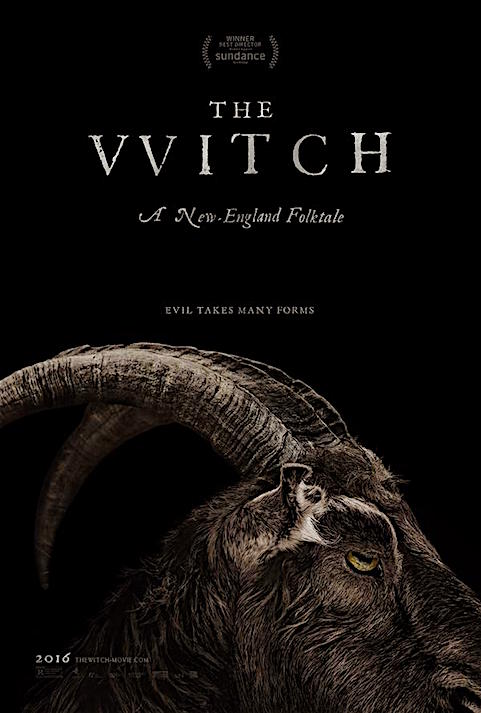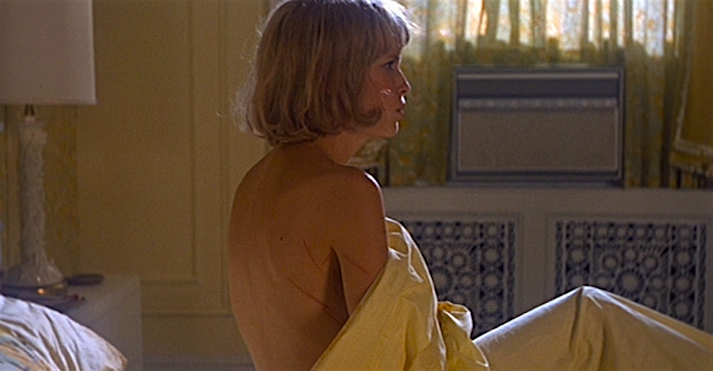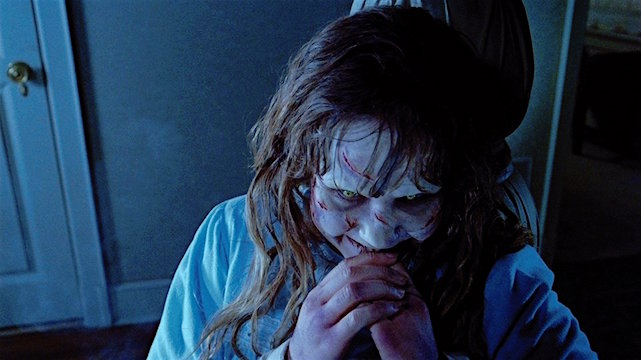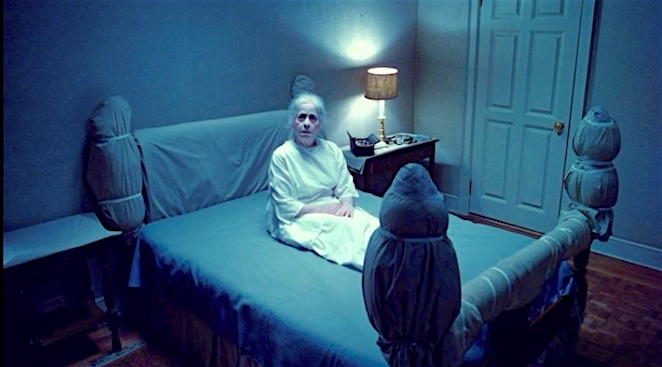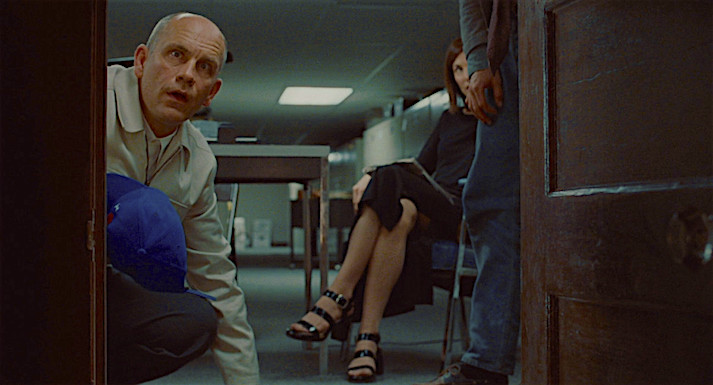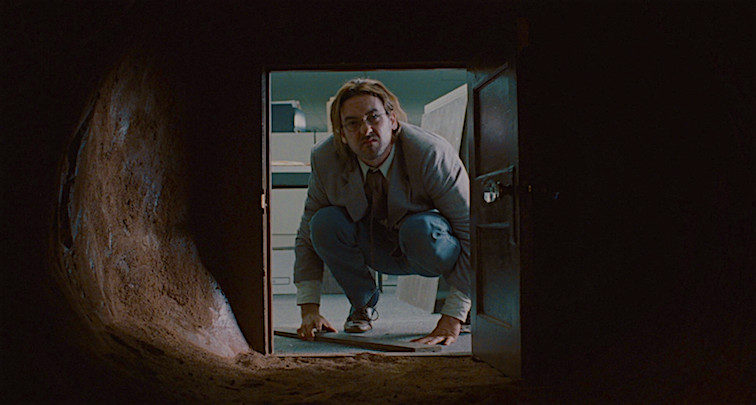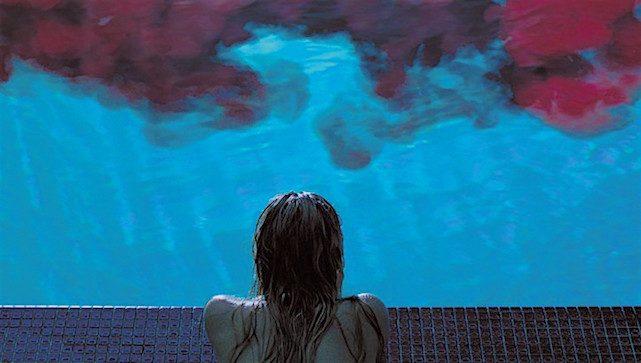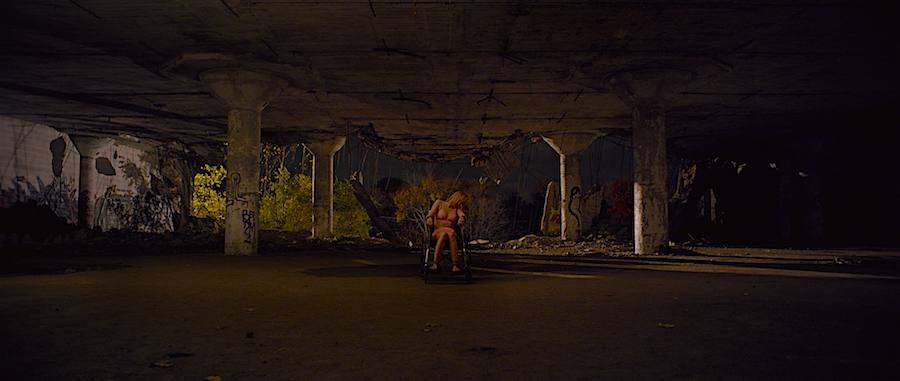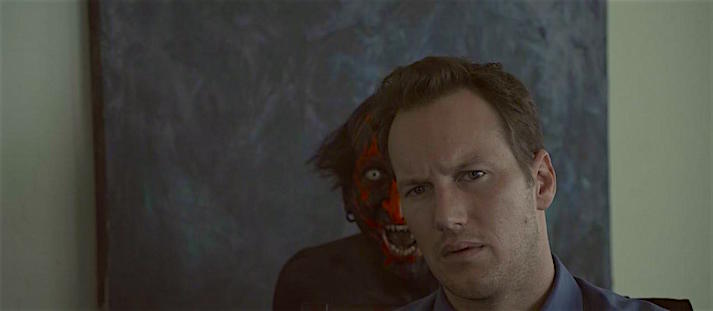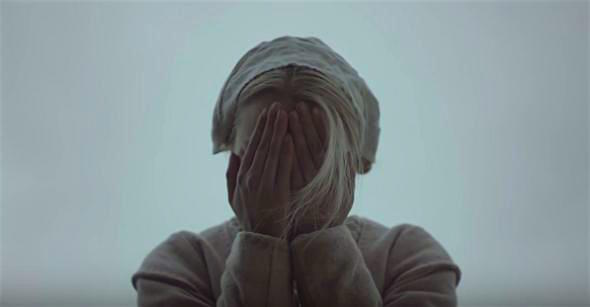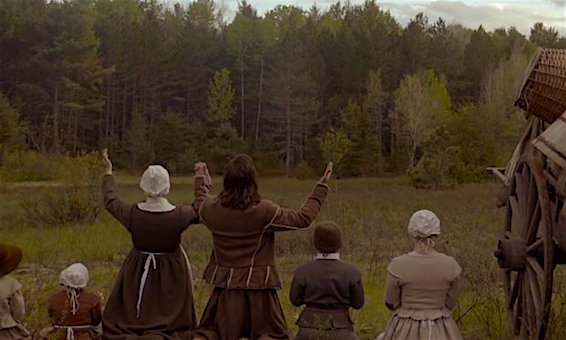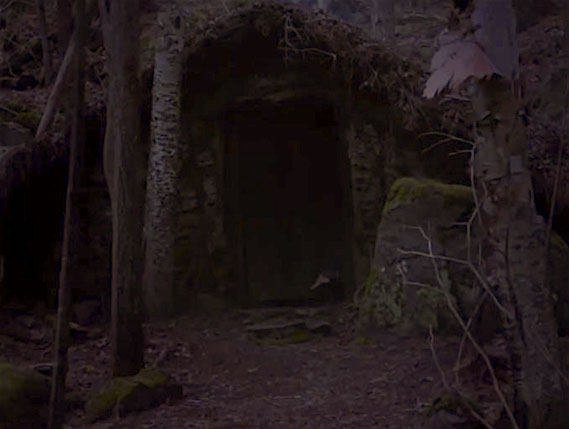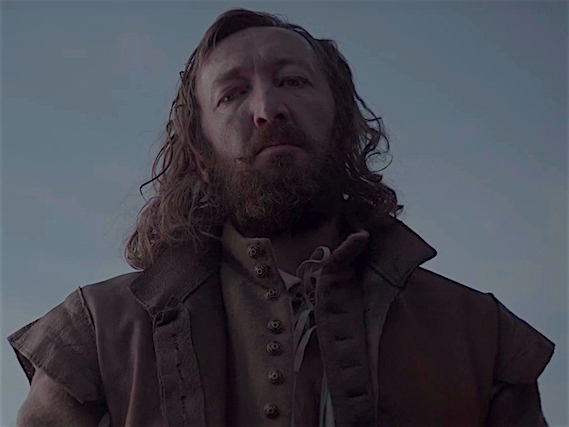As the bass, drums and orchestra kick in and we can hear Cher start to sing:
“Well I’m hell on wheels, I’m a roller mama. I can slide down places that you never knew. Try me on for size at the roll-a-rama.
If you tie my laces then I’ll follow you. Follow you! Follow you!!!
See something I like, gonna go for it
See something I want, I’m gonna go after it
See something I like, gonna go for it
See something I want… Let’s roll! Hell on wheels!! Let’s roll! Come on roll with me!
I roll at a quarter till three yeah
Let’s rock! Hell on wheels! Let’s roll!
Come on rock with me! I’ll make you feel so free! Yeah! Look out!!! “(voice echo effect)
Thus begins the infamous 1979 Roller Disco Movie which promises us “love on wheels!”

Cher croons a warning: “Look Out!”
Linda Blair & Jim Bray
Roller Boogie
Mark L. Lester, 1979
Cinematography | Dean Cundey
The 1970’s were a strange time. Gone were the revolutionary / political activism of the 1960’s. As our nation crossed over the years of 1969 to 1971, the idea of peace and love were starting to fade. By the time American Culture slipped in the haze of the 1970’s, people were more concerned with giving The World a Coke than offering peace and love. Chairs began to fully form into vinyl sacks filled with “bean-like” substances. Colors that should never have gone together were thought to match. Suspenders were no longer a utility, they were a multi-colored/glittered fashion statement. Men in Southern California and NYC began “perming” their hair. Blow-dyers were not something limited to the hairdresser, by 1974 this item was anticipated to be in every woman’s home. By 1978 every human being was expected to own a blow-dryer. Wings were no longer just for angels — they were for your hair. Your very dry/brittle hair. Drug use for mind-expansion quickly became a tool for fun and escape. Sexuality was no longer an aspect of “free love.” Sexuality was almost required of anyone over 16 as a political state of independence.

“Feels sooooo good. Sooooo good.”
Donna Summer
Giorgio Moroder
I Feel Love, 1977
The concept of The Sexual Revolution took a sharp left turn toward The Hedonistic. Love and sex became two very different things. The people who came of age in the mid-1970’s had rocks to love. This would be the era when gay men finally took a stand. Many of these men were especially trapped within the confusion of 70’s sexuality. Sex was not just for enjoyment is was an assertion of a human right — And, it was for all the world to see. Despite all the tackiness and odd ideas — Bataka Bats, anyone? Earth Shoes? Male half-shirts? Mini-shorts with tube socks? Bell-Bottom jeans? Special chain guards for bell-bottom pant wearing hipsters? The Brady Bunch? Battle of the Network Stars? Jeff & Pink Lady? The Bay City Rollers? Herpes?

Battle of the Network Stars
Sadly it would take us till about 1982 to fully realize how lame it all was. Not that we aren’t “nostalgic” for some of it, but I’m not sure any of us would be interested in having an elementary school Guidance Counselor make us hit her puppet with the Bataka Bat she kept in the corner of her tiny space. And while it is fun to watch Jeff & Pink Lady or Battle of the Network Stars on YouTube for a couple of minutes, would any of us really want to spend an entire weekend binging on them?
If there were ever a sign that the 1970’s were a profoundly horrible era for all of us it was the advent of a Euro-idea that transformed into what we call “Disco.” In fact, everything started to go firmly downhill after Disco thumped its way into our hearts and collective culture. As the fun offered by the multi-colored flashing floors of the discotheque started to become a bit tired, the situation took a very fast slip into an odd sensation that would sweep not only the US but Canada as well!
At the time it must have made sense. But it would appear that with a simple blink of the eye, Roller Rinks which had been content for us all to skate along with Billy Swan crooning “I Can Help” or Grand Funk Railroad’s reworking of “The Locomotion” suddenly magically became Disco Roller-A-Ramas. I remember being a child at a friend’s innocent Roller Rink Birthday Party when “Disco Duck” and “I Feel Love” began to throb throughout the huge space. The lights dimmed and glitter balls began to twirl. Multi-colors spraying out in all directions. Suddenly, KISS was no longer rockin’ our world. No. It was that quick. Rick Dees, Donna Summer and The Bee Gees has replaced Grand Funk, The Bay City Rollers, Peter Frampton, Heart, Fleetwood Mac and Dear Sweet God — Billy Swan!!! It only took our little heads a couple of minutes to find our rhythm regain appropriate sway. Our wheels took to this new level of pulse once they began to roll across the throbbing wooden floor.

Roller Disco Dancin’ Baby!
Soon we were rollin’ and disco’ing our way around the circular run that was our Roller Rink. We were not simply roller skating. No way, Baby. We were Disco Roll-A-Rama Skating. We were 7 and 8 years old hip disco rollers! And, for about 3 weeks it seemed cool.
Now. Before we engage in any discussion of Disco and the sad tilt down the ramp of Disco Roller Skating which would call Hollywood to take up any slack that might be left in our degenerate swag — we must discuss the American Anomaly we all call Cher.

Cher is more than ready to roll…
Photograph | Harry Langdon, 1979
Yes, you know who she is. And you are lying if you do not own some music or a movie featuring her unique skill and talent.
Hey! You! Yeah, you! Super Cool Rock Dudes! No! Even you can’t escape the bitter truth!
Think about it. That was Cher on the cover of the now iconic Rod Stewart LP cover. And, take a deep breath, Cher rocked it down hard with Gregg Allman and his brothers. And if you’ve still not fallen prey to the truth: Cher was also gettin’ down with Gene Simons of KISS. If for some reason you refuse to admit any claim to Cher, check with the person nearest to you.

Gene Simmons and Cher
…eating a wiener.
c. 1979
Photographer | Unknown to me
One of the two you have listened, watched and paid for Cher and her follies. They even gave her an Oscar!
One could debate if Cher really understood how “jacked” into the fleeting “cool” moments of our collective culture at just the right times. Back in the day, Cher’s motives do not seem as calculated as her fellow celebrities and artists. But none can deny that some sort of Divine Benevolence has always guided Cher to the epicenter of cool.

Sonny & Cher
c. 1966
Photograph | Michael Ochs
When she cut her own “bangs” and put on an ugly-ill-fitting sort of vest and sang “The Beat Goes On” with her Svengali-like husband, how could she have known it was jet her to a level of fame beyond understanding? Even later in the late 1960’s and very early 70’s as the Sonny & Cher records screeched to a stop, she would follow Sonny to Las Vegas. They made a great deal of money in the “unhip” Vegas. Their style and Cher’s sarcasm turned Vegas toward a new kind of cool. Not far behind them would be the likes of Tony Orlando & Dawn, Diana Ross and Streisand. True, they would make more money — but it is doubtful that they would have made the trek to that Frank Sinatra/Dean Martin saturated world first. Does anyone really think that an early 70’s Streisand went to Vegas because Liberace asked her? No. She and the others flocked there because Cher went there first. It was around this time that Cher would follow Sonny to the land of TV. They were a hit for a quick year or two. She stumbled into Warren Beatty who she decided to sleep with because she had nothing better to do. As Sonny & Cher began to fade and tabloids reported of a tryst with Beatty and her divorce. Cher happened to meet a

Does Cher’s 1974 album cover remind you of Stevie Nick’s Belladonna Album of 1981? …Cher Factor!
Cher
Dark Lady, 1974
Fashion | Calvin Klein
Photograph | Richard Avedon
then major Power-Broker who had yet to achieve household fame, David Geffen. Sure Beatty just wanted to score and Geffen was about as Gay as Gay gets, but Cher didn’t realize either of these things. No, she simply liked Geffen and he found true fame with her at his side. She also found her way into Studio 54. At the time, many hipsters of the day doubted Cher had what it took to party among the NYC Elites of Andy Warhol, Mick Jagger and Sylvester. But come on. We are talking about Cher. Her entry into the doors of Studio 54 was at the exact moment it became mainstream noticed. And while we cannot directly link Cher to the drug addictions of Liza Minnelli, Mikhail Baryshnikov and Gary Valentine, but many suspect that The Cher Factor is at least partially to blame.
Cher liked Disco music. She deemed it fun and cool. Yet, she would not run to the recording studio to record it. No. She was too busy with Gregg Allman, his brothers, Gene Simons, KISS and toying with idea of staring in some Anti-Vietnam movie called Coming Home and even a remake of A Star Is Born. These would have been logical, sound and smart marketable choices. But Cher was busy. No, not with a TV Show or in a recording studio. She was busy figuring out Aerobics. This was long before Barbra Streisand, Goldie Hawn and Jane Fonda even put a toe in the gym. Yes, true fact.
And while Ms. Fonda marketed Aerobics & Fitness to the masses and made millions. It was because her two pals, Barbra Streisand and Goldie Hawn were discussing politics over odd bodily contortions. But Streisand and Hawn only showed up to the Aerobic Studio because Cher was bending her body in positions that remain a thing of un-photographed legend. Tragically, these career opportunities were just for fun for Cher. She didn’t make any real money from these things.

Putting up the Cher Take Me Home billboard.
LA, 1979
When Cher finally turned away from the sound of Rock and California-Country-Rock toward the Disco she had been playing within, she was a bit late in recording it as her sound. It would be in the mid-point of 1979 before Cher would find her way into Bob Esty’s Disco Studio. She scored a hit single with Take Me Home plus Barry Levine captured her in Bob Mackie designed “Cher Disco Armor!” on an album cover. That album didn’t sell badly, but it didn’t sell great. But her one single sold.

Cher
Bob Mackie Disco Armor!
Take Me Home, 1979
Photograph | Barry Levine
Cher was the Secret Pioneer, but she was no marketing/selling match compared to Barbra Streisand’s The Main Event single or far less compared to the infamous and iconic Power-Diva-Duel that would become the Streisand/Summers’ massive hit, No More Tears (Enough is Enough.) We have no real way of knowing if Cher was bothered. I mean Donna Summer was sitting on an old-fashioned Radio and Barbra was soaked Wet and looking more than a little bit confused. Just as audiences had rushed to see Jane Fonda in Coming Home and Streisand in A Star Is Born, Dolly Parton and Linda Ronstadt secured the concept of country-pop-rock and translated them into big hits. And of course, it would be Jane Fonda who would whisk past Cher as well as Streisand/Hawn to Aerobic Glory.
I must apologize. I have just taken us into the 1980’s. OK. Let’s kick it back a couple of years. Cher has already decided she should endeavor to make a Disco record, but it would have to wait a few months.
Why?
Well, Cher was far too busy having fun. True, her second marriage wrecked in under several weeks, a new baby arrived, an eager young daughter and a frustrated Gene Simons simply refused to join her. But she left one issue and three individuals with the Nanny(s) and took off to Brooklyn.
Why would Cher skip over to Brooklyn and out Studio 54? And you must remember: just Studio 54 was really only heating up with the Ride of The White Horse. And things between Debbie Harry and Truman Capote/Andy Warhol were forming into Art as Jessica Lange wedged her way between Mikhail Baryshnikov’s coke spoon and an increasingly frantic yet dazzling Liza were catching the public’s interest.

Why bother with Studio 54?
Cher
Brooklyn Disco Roll-A-Rama, c. 1976
Photographer | Unknown to me
You see, in early 1977, one had to go to Brooklyn to Disco Roller Skate in true style. Cher rolled out a whole new type of fashion into her excursion into The World of The Roll-A-Rama Disco! Skates had to match the outfits and the outfits had to be sexy, fun and provocative! Bob Mackie was her real friend and was more than happy to assist. She owned that rink in all her see-through glitter costumed glory!

Cher
Boobies by Cher
Dress by Bob Mackie
Photograph | Harry Langdon
The only reason her agent and Bob Esty was able to drag Cher out of that rink was because she had heard — in what one can safely assume was presented in the form of a plea to her — Cher finally admitted that she was Disco Roller Skating Fanatic. Bob Esty worked like a speed-freak with Michele Aller to compose a song called, Hell on Wheels. It only took the mention that they written what they considered a true Disco Roller Skating Anthem to get Cher and her family back to LA to record that song. She also ended up recording enough songs to fill two albums which were largely fueled by the Disco Sound.

Cher is Disco-Rollin’ with un-named friend. The Disco Boobies and the Disco Skating that would inspire a Hollywood Marathon Sprint!
c. 1977
Photographer | Unknown to me
One problem: This was now 1979 and the Anti-Disco Movement was building momentum. Cher barely had time to squeak out one hit. This now leads us away from Cher directly to an atrocity that her Factor helped to fuel in The Land of Hollywood. However, in all fairness to Cher — she probably knew nothing of the impact of her actions and Disco Anthem.
Hollywood had no problem with grabbing onto Disco Culture, but the subculture of Disco Roller Skating would allude their radar. The executives should have been paying better attention to The Cher Factor. But to be fair, none of us did. The Cher Factor is usually so far-ahead of the Cultural Curve that it is only obvious with the gift of hindsight.
Irwin Yablans had been an instinctive film producer. He was inspired by Cher’s sheer Disco Roller Skating Boobies images and got wind that she was about to record a Disco album! Irwin Yablans, in some ways is like Cher. He didn’t really need to put on the skates. The bump, grind and jiggle of Cher’s meshed boobs was all he needed for cinematic inspiration.

The single that failed to chart until Roller Boogie which it would help to inspire.
The Cher Factor
Cher
Hell On Wheels, 1979
from the Prisoner album
Photograph | Harry Langdon
Remember, the world of film would not have John Carpenter’s Halloween had Yablans not suggested the idea of a babysitter serial killer slasher movie to the young director. So when Yablans suggested the idea of a Disco Roller Disco movie to screenwriter, Barry Schneider, he quickly wrote what became Roller Boogie. There seems to have been a brief period when the Yablans’ project was stalled. Apparently, Schneider wanted the male lead to be a struggling song-writer and the lead actress to be the solid Disco-Rollin’ Mama. For whatever reason, this idea didn’t suit Irwin.
He was also not particularly easy in appealing to “the R-Rated Adult Audience” demographic. Kids. Irwin wanted to pull in and do it for the kids. And to do that the leading man would need to be an instant winner and cool.
When they were ready to, um, roll, Linda Blair was their first and only choice for the Leading lady.

Linda Blair
Hollywood, c. 1977
Photographer | Unknown to me
Linda Blair had instant name recognition, she was hot but not too hot and she could be had on the “cheap.” This had nothing to do with her talent or her fame. This was because she had recently laid claim to negative “infamy.” Yep. Poor Linda had strayed from the world of Demons and Rick Springfield and had found her way into the world of real rock, via Lynyrd Skynyrd and cocaine. I’m not quite clear on how that band came into play, but it did. There are a number of photographs from 1975 to 1977 that feature Linda with Ronnie Van Zant. Anyway, poor Linda had gotten into some trouble. But she was no Lindsey Lohan! She got it together pretty darn quick.

I’m not sure any of us want to understand how Linda became close to this dude and his fellow-brilliant musicians. But it was probably not a very good idea…
Linda Blair and Ronnie Van Zant
c. 1975
Photographer | Unknown to me
For Irwin Yablans and his limited budget there was only one choice for his Leading Man. True he did initially agree to Linda Blair’s request that he cast her then boyfriend. But by the times the cameras were ready to roll, she had kicked him to the curb. So there was only one choice. On paper, it would make sense to cast Jim Bray in the leading male role because he was a big deal within the Roller Skating World an “artistic roller skating champion,” but in reality it was probably a poor choice. It still puzzles me why they didn’t pull Jimmy Van Patten from out of the supporting cast and into the lead. Jim Bray was able to skate, but he wasn’t particularly great-looking and was — well — kind of scrawny with no real charisma. Jimmy Van Patten is clearly dying to jump to the head of the class, he was well built, better looking and just cooler.
The other issue with Bray in the male lead is that he just seems “small” next to Linda Blair.

Let’s Roll! Let’s Rock!
Roller Boogie
Mark L. Lester
Cinematography | Dean Cundey
It is here that I find it essential to contradict something to which people always refer: Linda Blair was not fat. She was not the slim, in-shape beauty she is today — but, seriously, Linda Blair was not fat. She was seriously hot. Even in The Age of Disco, most straight dudes would have gone for Linda over any 3 of the Charlie’s Angels.
Why? Because she was naturally hot and nothing seems “high-maintenance” about her. She is accessibly hot. However, when Mark L. Lester has stand her next to a 95lbs guy like Jim Bray — it looks “off.” This is why there are so many shots of both by themselves or shots together are carefully framed so that Bray’s skinny physique is not interacting with Blair in obvious ways.

A tender moment…
Jim Bray / Linda Blair
Roller Boogie
Mark L. Lester, 1979
Cinematography | Dean Cundey
But then again, Jim Bray is one of the odd-fitting pieces that help to make the Cinematic-Taint we all love called Roller Boogie. Had the equally hot Jimmy Van Patten played opposite Linda Blair, Mark L. Lester and Yablans probably would not have felt it important to cut “the not quite R-rated sex” scene. This was not cut because it would have gained an R-rating — it was cut because I think we can all admit it would have been “uncomfortable” to think about Linda doing the deed with Jim Bray. Poor Jimmy Van Patten. It would be his younger brother, Vincent Van Patten, who would get his day in the sun with Linda Blair in the R-rated Hell Night. Wait. Maybe we should feel more sorry for Vincent.
Back to focus:
Production of Roller Boogie went fast. It had to. Just as they went into production — Columbia Studios was financing a bigger budgeted Roller Disco Movie staring Scott Baio, Marcia Brady, Ruth Buzzi, Playboy’s Dorothy Stratten, the screen debut of Patrick Swayze and the sought-after prize that was Flip Wilson. This movie was called Skatetown, U.S.A. As it turned out, this turned out not to be a problem.
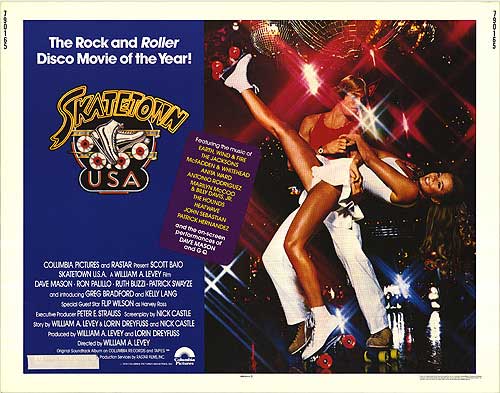
Skatetown USA
Cinematic Error
Trust me, the poster is the only entertaining thing to be found in this movie.
Columbia and Rastar did beat Yablans to the screen by 2 months, but Skatetown, U.S.A. was DOA upon arrival to the cinemas. There was also a great deal of pressure to get the production filmed before Poor Linda had to be in front of a judge in Florida to face the music for her post-Exorcist II: The Hertic-Lynyrd Skynyrd-Cocaine Adventure of 1977. Production completed just in time for Linda to catch her plane and Jim Bray to visit Studio 54! Roller Boogie might have not arrived until December of 1979, 2 months after Skatetown, U.S.A., and more than several months after the Historic Disco Demolition Night — but Linda Blair and Jim Bray in Roller Boogie were a hit. Skatetown, U.S.A. was a major flop and only sounds good-bad fun. It is actually just very bad.

Still much disco work to be done through 1981. Disco had a slower death than many expected.
Andy Gibb
After Dark Magazine
And while Disco Demolition Night did have some significant impact, Disco Culture was not quite done yet. Disco would not fully die until early 1981. Just in time for the ULTIMATE big-budget Disco Roller Skating Movie, Xanadu, to arrive. Xanadu’s soundtrack sold well, but the movie tanked.
Here is my challenge: The Notorious & Much-Beloved Roller Boogie was recently restored and re-issued to Blu-Ray by Olive Films. I was asked to review it. But you know I think I can sum up Roller Boogie fairly fast. Almost as fast as The Disco Roll-A-Rama Fad.

Linda Blair cruising with her best friend, Big Tits.
Roller Boogie
Mark L. Lester, 1979
Cinematography | Dean Cundey
Linda Blair is a classically trained flutist who doesn’t really appear to know how to play the flute. Her mastery of the flute reminds one of another oblong thing. Linda Blair gently massages her flute while teasingly gently blowing upon it’s head. Get your mind out of the gutter! The head of the flute! Linda’s flute-ing appears to be “sync’d” in. Anyway, her mom is the Step Mom from My Three Sons. And she is stressed-out! Linda’s Daddy is really rich. He gives Linda everything she wants except her freedom to really get her roll on! She has two friends: One is female. I can never recall her friend’s name. I call her Big Tits. Her other friend is a an early version of geek+Yuppy.
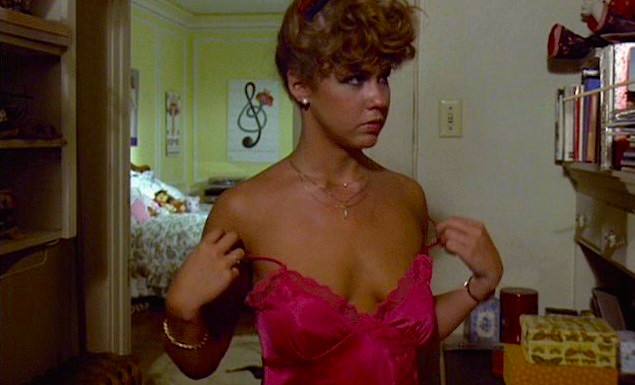
“Hmmm. Should I let it slip a little further down?” giggles. “NO!”
Linda Blair in her closet
Roller Boogie
Mark L. Lester, 1979
Cinematography | Dean Cundey
Linda contemplates the weary challenges of being rich, forced manipulation of a flute and best friend, Big Tits, who claims to be her age but is probably lying. Linda is pretty sure Big Tits is pushing 30. So it is time to change clothes and do what she needs to do!

“Outfit. Check. Skates. Check.”
Linda Blair
Roller Boogie
Mark L. Lester, 1979
Cinematography | Dean Cundey

“OK. Hot enough!”
Linda Blair
Roller Boogie
Mark L. Lester, 1979
Cinematography | Dean Cundey

“I’m outta here!”
Linda Blair
Roller Boogie
Mark L. Lester, 1979
Cinematography | Dean Cundey
Linda gets fed up and drives her sleek and way-cool car that has a telephone in it! She goes where all wealthy Beverly Hills girls go to rebel and be cool – Venice Beach!

The flute can wait! I gotta learn how to disco roller skate!
Linda Blair on what I believe is an early form of a cell phone attached to her fancy car.
Roller Boogie
Mark L. Lester, 1979
Cinematography | Dean Cundey
Here she happens to notice a Totally Hot Stud, Jim Bray!, who we have already had the benefit of seeing — but as he rolls up, Linda is unable to escape his boy-ish charm. He lives in a seedy hotel! (only we the viewers seem to be aware that Jim Bray is most likely a rent boy who skates to peddle his ass, but this may not really be true) — Anyway, Linda works her permed-giggly charm on Jim. She had him at her brief confusion determining if he is her leading man and not some gay hooker who rolled up on the set.

Whoa! Wait. Is that the leading man? Oh, yes. Well he is ONE HOT HUNK OF A MAN!!! …in mini-shorts, tube socks, skating around Venice Beach. No worries.
Jim Bray doing his best
Roller Boogie
Marl L. Lester, 1979
Cinematography | Dean Cundey
One thing leads to another and Jim teaches Linda how to Disco Roller Skate. He really had to — she already had all of the wardrobe and the skates. She just needed the skill. In truth, I think Linda was just using the Disco Skate Lessons as a ploy. She wants him. She clearly knows how to dance. The real “training” seems to be in this frail hustler’s ability to “lead” and “lift” anything above 30lbs.

So far so good. Now Jim, turn and hoist Linda above your head!
Jim Bray / Linda Blair
Roller Boogie
Mark L. Lester, 1979
Cinematography | Dean Cundey
But he masters it. Linda’s friends and family do not accept her interest in pursing this Cher-like lifestyle. She has to go to Juilliard and sign with some classy classical music label to play the flute! Jim’s friends, who are all a way lot better-looking — especially the Van Patten boy, all like Linda and Big Tits!

Jim’s pals!
Little Jimmy Van Patten in yellow. Are you sure he is not Linda’s leading man?
Roller Boogie
Mark L. Lester, 1979
Cinematography | Dean Cundey
But they worry that she is going to crush his heart. Also he’s not bringing in his share of the sex bread. He is spending way too much time skating around with Linda. And she’s not paying! Jammers is Jim’s Disco Roll-A-Rama of choice. Cue Audience: “Of course it is!” But Jammers is about to go down due to some shady deal to build senior housing. Senior Citizen’s don’t need housing on Venice Beach! Not when the kids need Jammers! Comic mayhem ensues! It all comes to a head and a happy conclusion at the Big Jammer’s Roller Boogie Competition!

And, Hoist! The Winners!
Linda Blair/ Jim Bray
Roller Boogie
Mark L. Lester, 1979
Cinematography | Dean Cundey
Linda & Jim want to win! And all of Jim’s pals and Big Tits cheer them on. They win! And Jammers beats the evil attempt to take away their Disco Roller Fun!
In the end, Jim and Linda take a sunset walk. Yes. A walk. Not a disco roll. They love each other, but they need to take care of few personal issues first. Linda has to achieve Flute control and fame in NYC. And, Jim explains to her that he is going to take his Disco Roller Skating skill to the US Olympics!

Time to put our roller disco love on hold.
Linda Blair / Jim Bray
Roller Boogie
Mark L. Lester, 1979
Cinematography | Dean Cundey
They kiss. Linda drives away. I searched the disc for that Easter Egg feature that would at last allow me to see Linda discuss all of this with Big Tits. I could not find it! But I am fairly sure I know how Barry Schneider wrote it.
Final Scene: Airport Gate
Linda leans on Big Tits.
Linda: I’m going to miss you sooooo much, but I’m going to miss my Jim more!
BT: Just fly him out to NYC. No major.
Linda: Oh, no! I couldn’t do that to him. He’s on his way to disco skate for the US Olympics!
BT: Like, Oh my God! Linda? Disco Skating is not an Olympic Sport. I mean, like, it’s barely a “thing.” As if!
Linda: Oh, no! I need to let him know! He took the Roller Boogie prize money to get to the Olympics!”
BT: Look. Jim is a man-hooker. Ok? He took that Roller Boogie prize money to buy some new mini-shorts.
Linda: Oh, no! Don’t be so silly! You are such a goof, Big Tits!
BT: Look, Kiddo — you just focus on mastering the flute and the real men will be crawling to you!
Linda: K! Byyyyeeee!
The End

Jimmy Van Patten, Coke-Fueld-Disco Skate Fan & Big Tits give a hand for Linda & Jim! Well, Van Patten is more upset that he’s not skating with Linda, but he’s doing his best.
Cue formerly failed Cher disco single.
The way I see it, if you haven’t already seen the incredibly bad-good fun that is Roller Boogie. You need to. Go on line, but the Blu-Ray or the new DVD from Olive Films. It’s cheap! You will not regret it. I think one of the main reasons Roller Boogie remains so much fun to watch and re-watch is that it is the extreme opposite of movies like Saturday Night Fever and also far better than lame movies like Skatetown, U.S.A. There is nothing “realistic” about it.

Jim laces Linda up!
Roller Boogie
Mark L. Lester, 1979
Cinematography | Dean Cundey
It embraces only the fun and innocent side of things. There is plenty of room to project and talk back to the screen if you feel the need. The comedy and subplots are so very bad — they become fun. By the way, a sequel was planned, it was to be titled Acapulco Roller Boogie. Tragically, this film never came to be.
And there is The Cher Factor going down. The producers were able to use Hell On Wheels for the movie’s theme song. It was included on the mildly well selling soundtrack album.

The soundtrack for Roller Boogie featuring “a song by Cher”
However, Hell On Wheels was not recorded for the movie. This is mistake many make. This was a track off her second Disco-oriented album called Prisoner. It had been released as a single as shown far above in this post. But Roller Boogie gave the song a “re-visit” and it became a minor success. A very early Cher music video for Hell On Wheels started to gain some air-play. Even with a broken arm, Cher skillfully Disco Skated with the aid of holding onto moving cars! The vid-clip was not made for Roller Boggie. If you look close, you can still find it on YouTube. Wait. Now that I think about it. Cher’s disco vid-clip might ever very well inspired Olivia Newton-John to use video to promote her Physical album. Well, that’s The Cher Factor.

Linda Blair requests some new laces for her skates.
Roller Boogie
Mark L. Lester, 1979
Cinematography | Dean Cundey
It is not clear if Cher is even aware of this movie. No one knows and no one is going to ask her. Don’t go there. Just a friendly warning.
But were it not for Roller Boogie, Cher’s Hell On Wheels would have been lost forever. …sort of like that “punk” rock album she made which was actually more like pop attempting to be New Wave. Black Rose, anyone? It doesn’t matter. Something made her curious about this thing that used to be called Broadway. She sort of fell into a role for a Robert Altman play that became a movie. Then she “hung” out with Mike Nichols and Meryl Streep and on her way to Vegas, she took a brief stop and made a movie called Silkwood. She would have to put off her plans for Vegas for a while. She ended up making a lot of movies that made a lot of money. She had sex with Tom Cruise but rolled her eyes at the idea of Scientology and hooked-up with this cool dude who made bagels in NYC. She won an Oscar on her way to a party Madonna was giving. She recorded some really big-selling albums in the late 80’s. She called David Letterman on his shit. Then she got bored.

The LAPD is always trying to crash the fun…
Roller Boogie
Mark L. Lester, 1979
Cinematography | Dean Cundey
Flights to Vegas were booked. So she went back to LA. She directed an acclaimed Pro-Choice HBO movie. This dude talked her into recording a pop album that used this odd microphone that changes the human voice. He was gay and kind of cute so she listened. The music reminded her of Disco and all that fun she had on skates. Several publicists explained this was not “disco” music. This was “club” or “dance” music — like Madonna only without the sex. For Cher, this was a good thing because, well, you know She was tired.
She was diagnosed with Chronic Fatigue Syndrome. She dealt and kicked it’s ass. While the cause of this illness is still debated, I suspect we will eventually learn it is caused by being too fucking cool and independent. She did several — no, wait. I’m not sure. She did a lot of Farewell Concert Tours. She wrote a book. She did a lot more Farewell Tours. She supported her daughter when she realized that she was a he. Cher had always been generous with a buck, but made her philanthropy well known once she saw the shit with which her son had to deal.

Cher
Believe, 1998
She turned down leads in everything from Thelma & Louise to War of The Roses to a cinematic re-make of the musical Gypsy. Streisand was to direct Gypsy. Probably can’t blame Cher for turning that one down. But it does seem strange that she turned down the other two. Interestingly, as far as I am aware she has only one professional regret: An infomercial for a pal’s hair product. Yet, even this one Cher’s regretted mistake: Her infomercial is the thing of legend.
Cher is still tired.
Cher is not bored.
She is “creeping” about the Internet. So you better watch your ass! I’m not kidding. She will take you down. Don’t be giving Cher shit.

Cher
c. 1981
Photograph | Harry Langdon
Cher stopped taking shit after they took her Disco Roller Skates away. Never underestimate The Cher Factor. Seriously, you will regret it.
Somehow Cher is always correct. And Roller Boogie remains a very fun watch!
Matty Stanfield, 8.8.15










